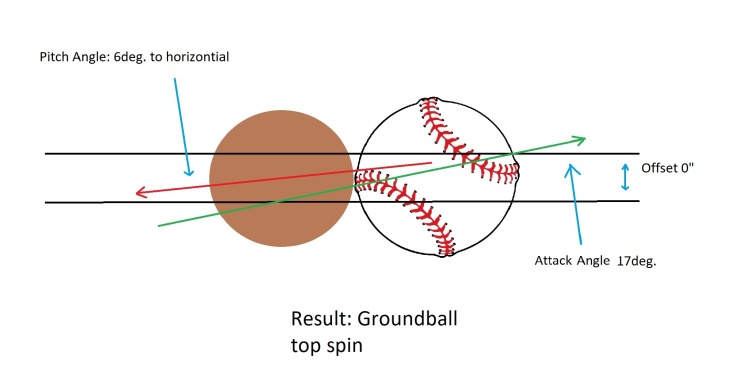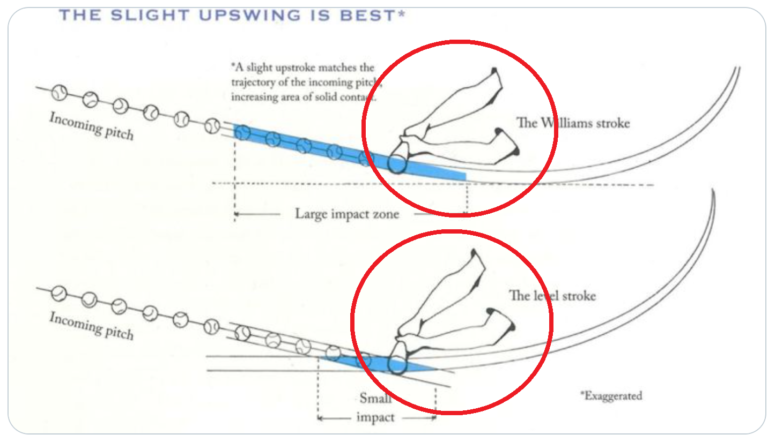
The Sweet Spot Balancing Power and Consistency in Baseball Swings
By Ken Cherryhomes ©2024
This paper is a follow-up to my previous work comparing downward and upward swing paths and their effects on optimal launch angles for maximum flight distances of batted balls. While that study focused on two extremes, 0-dgree flat attack angles compared to a 17-dgree attack angle, this one will examine a wider range of swing paths, this time considering the margin of error and difficulty of execution. As a hitting trainer and baseball tech inventor with experience in both applied and theoretical physics, I aim to provide insights into the practical application of various swing theories for individual batters. This paper will evaluate multiple swing paths and compare their outcomes to determine the most efficient and effective approach to hitting. Additionally, it will address the limitations of theoretical models and consider the importance of factors such as margin of error and probability of outcome. By doing so, we can provide a more comprehensive understanding of the physics of hitting and offer practical advice for players and coaches alike. -Ken Cherryhomes
Introduction
Swing path and attack angle are critical components in determining the outcome of a batted ball in baseball. Hitters and coaches are constantly searching for the optimal swing path and attack angle that will maximize batted ball outcomes. However, the ideal swing path and attack angle are still a topic of debate among baseball enthusiasts, coaches, and players. This paper will explore the physics of swing paths, attack angles, and their impact on batted ball outcomes in baseball.
Swing Path
Swing path refers to the trajectory the bat follows through the hitting zone and should be considered more as hand path rather than bat path. There are three main types of swing paths: upward, flat or “level”, and downward.
The upward swing path is characterized by a steep angle of the hand path through the hitting zone. The flat swing path is characterized by a level hands’ path through the hitting zone. The downward swing path is characterized by a steep angle of the hands’ path through the hitting zone in the downward direction.
Regarding level swing paths, it is important to note, while hand path may be level (to horizontal) the bat’s barrel can appear to be traveling a steep arc. Since our wrists articulate, the barrel is seldom equal to or above the hands at contact. Swing paths themselves mostly describe the hand path of the bat’s arc. If you’ve ever heard someone say, “swing level”, they are intending the hand path to the ball be level, not an uppercut path that results from a dropped back shoulder. They are also certainly not suggesting the batter chop down on the ball, though all hand paths have some downward arc to them, as the hands are generally launched from above the ball.

As for downward paths, unless the batter is “late” or their intention was to hit the ball on the ground, downward arcing swings rarely meet the ball with a downward or negative attack angle, as previously mentioned in the level path description. In respect to attack angles, which will be discussed later, all swing paths begin by moving downward, then eventually arc up, ascend. Attack angles, which are instantaneous, and are largely dependent on the point and depth of contact. While upward swings do not result in negative attack angles, they can and do still produce groundballs, which will be discussed later.
Attack Angles
Attack angle refers to the instantaneous angle at which the bat meets the ball. There are three main types of attack angles: upward, flat, and downward. The upward attack angle is characterized by a positive angle between the incoming pitch and the bat’s path through the hitting zone. The flat attack angle is characterized by a zero-degree angle 0-degrees +/- a few degrees between the incoming pitch and the bat’s path through the hitting zone. The downward attack angle is characterized by a negative angle between the incoming pitch and the bat’s path through the hitting zone. While a flat or 0-dgree attack angle may be captured, it usually won’t appear flat, the ball is almost always below the level of the batter’s hands, the vertical bat angle giving the illusion of a down-to-up bat path.
Impact on Batted Ball Outcomes
The optimal swing path and attack angle are critical in determining the outcome of a batted ball. The upward swing path is typically associated with home runs and fly balls, while the downward swing path is typically associated with ground balls. However, a flatter swing path has been shown to be a more effective swing path for producing line drives, which have a higher likelihood of resulting in a hit.
Similarly, the optimal attack angle is critical in determining the batted ball outcome. However, as I’ve discussed in my previous article for Inside Pitch in May/June 2019, ‘
“In pursuit of the Optimal Swing”, attack angles are highly sensitive to offset, the measure of obtuse impact between the bat and ball.
The upward attack angle is typically associated with home runs, while the downward attack angle is typically associated with ground balls. The flat attack angle has been shown to be the most effective attack angle for producing line drives, which have a higher likelihood of resulting in a hit. Furthermore, flatter attack angles can also produce both home runs/flyballs and groundballs, depending on the measure of indirect impact.
Margin of Error
It is important to note that both swing path and attack angle have a significant margin of error because they are timing dependent. Even a perfectly timed swing can result in a mis-hit due to small variations in swing path and attack angle. For this reason, it is important to consider the ease of execution and margin of error when determining the optimal swing path and attack angle.
For example, three perfectly timed swings meeting the ball squarely in the middle of the barrel and middle of the ball have different outcomes, surprisingly, one of which, the perceived “optimal’ attack angle for maximum flight distance is the least desirable, as depicted in the illustration.

Conclusion
Swing path and attack angle are critical components in determining the outcome of a batted ball in baseball. The optimal swing path and attack angle depend on a variety of factors, including the type of pitch, the hitter’s skill level, and the ease of execution. While the upward swing path and upward attack angle are typically associated with home runs, the flat swing path and flat attack angle have been shown to be the most effective for producing line drives and hits. Ultimately, the optimal swing path and attack angle should consider both the likelihood of producing desirable batted ball outcomes and the margin of error in execution.